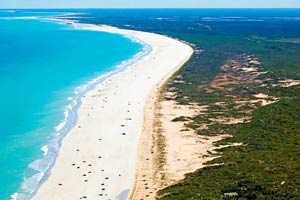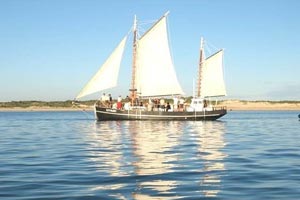
Without a doubt the most popular place to be in Broome is
Cable Beach. This 22-km long stretch of white sand, hugged by the turquois water of the Indian Ocean, got its name from the telegraph cable laid between Broome and Java in 1889. Apart from any sea-related activity under the sun, you can do a couple of unique to Cable Beach activities – take a camel ride at sunset and see
130 million-years-old dinosaur footprints at
Gantheaume Point at the Southern end of the beach, discovered only recently in 2016.

Roebuck Bay is an incredible natural coastal area where you can see rare flora and fauna, watch migratory birds at the Broome Bird Observatory, see rare snubfin dolphins, dugongs and turtles. The area is also sacred for the local Yawuru Indigenous people, used in the past for fishing, hunting and gathering of sea foods. Here you can see the “Staircase to the Moon” – a natural phenomenon, occurring in winter months and created by the rising of a full moon and its reflection over the tidal flats of the bay.
Considering Broome exists largely thanks to the silverlip pearl oyster Pinctada Maxima, discovered here in the 1880s, there are many attractions in the city, dedicated to this industry. At the Broome Museum learn about the fascinating pearling industry and how Broome became the first truly culturally diverse city in Australia thanks to the Japanese, Chinese and Malaysian pearl divers.  There are also informative displays about the WWII bombings, shipwrecks and missing diamonds and the local Aboriginal people. See the last two surviving Pearl Luggers, full of beautifully preserved memorabilia, book an informative tour and take home some locally produced, cultivated South Sea pearls. There are 919 graves at the Japanese Cemetery, most of them of pearl divers who died at sea while performing their duties. The statue of an aboriginal pregnant woman at Roebuck Bay, rising from the sea, desperately holding a pearl shell in her hands represents the grim practise of “blackbirding” – when aboriginal men and women were enslaved and forced to dive for pearls in the early days of pearling. The statue is called Memorial to the Indigenous Female Pearl Divers. Take a “pearl tour” at one of the two cultured pearling farms near Broome – Cygnet Bay Pearls and the Willie Creek Pearls– both offer a range of experiences, including showrooms in Broome for convenience. There are also numerous pearl shops and galleries in Broome with great prices and knowledgeable staff if you are looking to take home some of those locally produced gorgeous South Sea pearls.
There are also informative displays about the WWII bombings, shipwrecks and missing diamonds and the local Aboriginal people. See the last two surviving Pearl Luggers, full of beautifully preserved memorabilia, book an informative tour and take home some locally produced, cultivated South Sea pearls. There are 919 graves at the Japanese Cemetery, most of them of pearl divers who died at sea while performing their duties. The statue of an aboriginal pregnant woman at Roebuck Bay, rising from the sea, desperately holding a pearl shell in her hands represents the grim practise of “blackbirding” – when aboriginal men and women were enslaved and forced to dive for pearls in the early days of pearling. The statue is called Memorial to the Indigenous Female Pearl Divers. Take a “pearl tour” at one of the two cultured pearling farms near Broome – Cygnet Bay Pearls and the Willie Creek Pearls– both offer a range of experiences, including showrooms in Broome for convenience. There are also numerous pearl shops and galleries in Broome with great prices and knowledgeable staff if you are looking to take home some of those locally produced gorgeous South Sea pearls.
 There are a few more interesting and unique sites to see in Broome. Experience the Horizontal Waterfalls at the Buccaneer Archipelago at the remote north-west – a natural phenomenon, caused by the tidal waves that rapidly burst through the low emerald green islands, producing a unique, ocean-rafting thrill. See the WWII Flying Boat Wrecks on low tide (the boats are only visible during certain time of the year, check to be on the safe side), when it’s possible to walk over to them or take a hovercraft tour. The six flying boats that are visible, were part of a group of 15 that were evacuating civilian refugees from Java, mostly Dutch and British when they were attached by Japanese “Zero” planes during World War II on 3rd of March 1942. At Malcolm Douglas Crocodile Park see some of the largest crocodiles in Australia, set amongst large Kimberley lakes. The park is also a home to dingoes, cassowaries and many bird species.
There are a few more interesting and unique sites to see in Broome. Experience the Horizontal Waterfalls at the Buccaneer Archipelago at the remote north-west – a natural phenomenon, caused by the tidal waves that rapidly burst through the low emerald green islands, producing a unique, ocean-rafting thrill. See the WWII Flying Boat Wrecks on low tide (the boats are only visible during certain time of the year, check to be on the safe side), when it’s possible to walk over to them or take a hovercraft tour. The six flying boats that are visible, were part of a group of 15 that were evacuating civilian refugees from Java, mostly Dutch and British when they were attached by Japanese “Zero” planes during World War II on 3rd of March 1942. At Malcolm Douglas Crocodile Park see some of the largest crocodiles in Australia, set amongst large Kimberley lakes. The park is also a home to dingoes, cassowaries and many bird species.